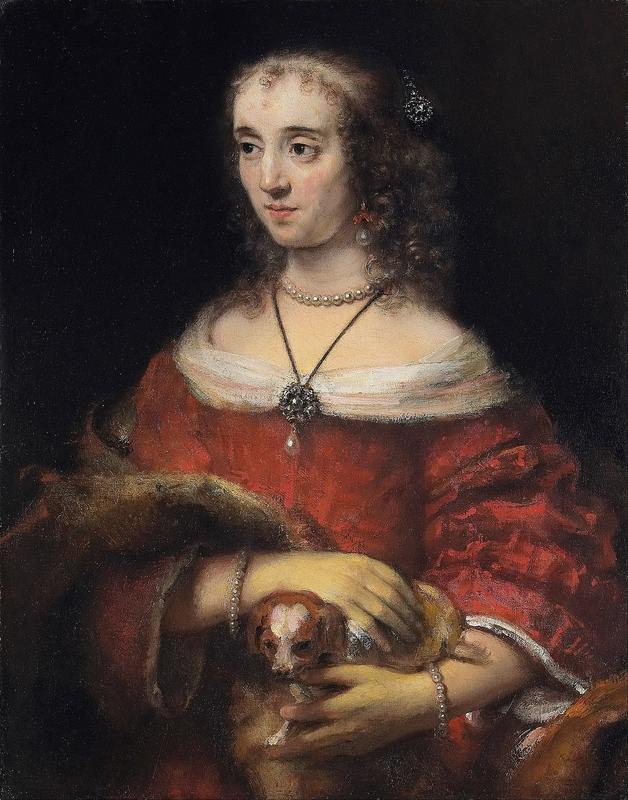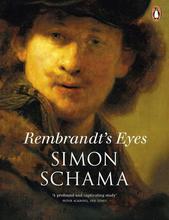More about Portrait of a Lady with a Lap Dog
- All
- Info
- Shop

Contributor
Even Rembrandt understood the precious value of a good doggo.
Adding dogs to paintings was quite fashionable in the 17th-century. They were used as both serious allegorical symbols and humorous background details to lighten the mood of a piece. In artwork that portrayed a busy, unconventional setting, dogs are often included in the background as comedic relief. One such painting depicts a Dutch brothel with two dogs hidden in the background doing the dirty doggy style, in all senses of the word. Dogs included in portraits, however, served a less tongue in cheek purpose.
The young woman in this portrait is Rembrandt’s daughter-in-law, Magdalena van Loo. She was 24 when this portrait was painted, though she looks much younger. Dogs in Renaissance paintings were often included as symbols of faithfulness or thriving domestic life. These small dogs were especially good companions for young women and in their portraiture, the dogs remind the viewer of loyalty, namely marital loyalty. Rembrandt painted this piece at the height of Magdalena’s courting period and she was married 3 years later. Coincidence? Or did an eligible young man see her portrait and think ‘hmmm she’s a little plain but hot damn she’s got a dog in the picture; she must be super loyal and obedient.’
The pup sitting in Magdalena’s lap appears to be a spaniel, most likely a Cavalier King Charles Spaniel (which was referred to as a “toy spaniel” at the time). These dogs are small, quiet, and very affectionate: the ultimate lap dog. Their nickname became the “comforter spaniels” as they were breed to keep the nobility’s laps and feet warm. Yes, you read that right, they were living hot water bottles. The breed was first popularized by King Charles I, hence the breed’s name, and then King Charles II, who loved the breed so much that he made a royal decree that King Charles Spaniel had to be accepted in any public place, even in the House of Parliament. Hey, even politicians who are deciding the fate of the country get cold.
As a woman, being compared to any animal, even a dog, doesn’t feel great. I don’t think I need a dog in each of my Instagrams to convince people that I’m loyal and faithful. But, if I had to pick one to be compared to, a dog named after royalty doesn’t seem like the worst option.
Sources
- https://artsandculture.google.com/asset/portrait-of-a-lady-with-a-lap-d…
- https://www.washingtonpost.com/archive/lifestyle/style/2006/04/30/rembr…
- https://www.britannica.com/biography/Charles-I-king-of-Great-Britain-an…
- https://www.dailydogdiscoveries.com/tag/history-of-lap-dogs/
- http://www.pennsburymanor.org/animals-and-art-in-the-17th-century/
- https://www.sophieploeg.com/blog/dogs-in-dutch-genre-painting/
Featured Content
Here is what Wikipedia says about Young Woman with a Lapdog

Young Woman with a Lapdog (Dutch: Portret van een vrouw met schoothondje) is a c. 1665 oil-on-canvas painting of an unknown young woman by Rembrandt. It is now in the Art Gallery of Ontario, to which it was bequeathed in 1955 by the philanthropist Frank Porter Wood. It was previously identified as Rembrandt's daughter-in-law Magdalena van Loo (1641–1669), but the subject is now held to be unknown.
X-radiographs reveal significant changes to the bottom half of the painting as Rembrandt explored lighting and color. According to Ernst van de Wetering, this aspect of the work reveals "the 'Late Rembrandt' at his best". The painting is not signed, but may have been before later overpainting.
Check out the full Wikipedia article about Young Woman with a Lapdog













